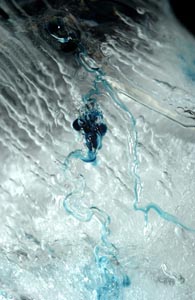Crystal Clear?

Teachers use a flashlight to explore an ice
balloon.
Crystal Clear?

Teachers use a flashlight to explore an ice
balloon.
Material
Balloons
salt
food coloring
a flashlight
A shallow tray to collect the melt water.
Assembly
Fill the balloons with water and put them in a freezer two days before you plan to use them.
To Do and Notice
Take the ice balloon from the freezer.
Peel off the balloon.
Put it in a tray to collect the melt water.
Examine the ice. What do you see?
Sprinkle salt on top of the ice. What happens.
Add drops of food coloring to the salted places.
Notice tyhe air bubbles in the ice.
Are their fractures?
Notice that the salt causes the ice to melt.
The melt water flows down the sides of the ice carving channels as it
flows.
The channels wind back-and-forth, they meander, as they
flow.
The food coloring makes the flow more visible.

What's Going On?
When water freezes it expels impurities.
In particular, air dissolved in the ice comes out of the ice as air
bubbles.
The ice freezes from the outside toward the
center.
At first the air expelled by the freezing ice can dissolve in the
remaining water.
But eventually, the water becomes saturated with air. Then further
freezing will cause air bubbles to form. This is why the air bubbles
are inside the ice.
The ice expands as it freezes. After the first ice freezes to make a solid casing, the inner ice freezes and expands making cracks in the outer ice.
Adding salt to ice lowers the freezing point, some of the ice melts. The melt water flows down the side of the ice. As it flows it meanders.
The meanders allow the flowing water to lose energy at a constant rate, the water flows at a constant speed through the meanders. (Just like a skier controls speed by making turns down the fall-line of the slope.). If the water flowed straight down the side of the ice it would accelerate and lose energy in a nonlinear way.
|
Scientific Explorations with Paul Doherty |
|
23 September 2005 |